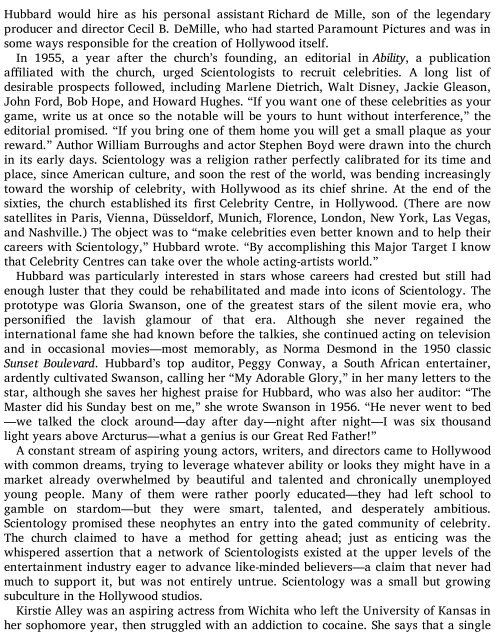going-clear-scientology-hollywood-and-the-prison-of-belief-by-lawrence-wright-2
going-clear-scientology-hollywood-and-the-prison-of-belief-by-lawrence-wright-2
going-clear-scientology-hollywood-and-the-prison-of-belief-by-lawrence-wright-2
You also want an ePaper? Increase the reach of your titles
YUMPU automatically turns print PDFs into web optimized ePapers that Google loves.
Hubbard would hire as his personal assistant Richard de Mille, son <strong>of</strong> <strong>the</strong> legendary<br />
producer <strong>and</strong> director Cecil B. DeMille, who had started Paramount Pictures <strong>and</strong> was in<br />
some ways responsible for <strong>the</strong> creation <strong>of</strong> Hollywood itself.<br />
In 1955, a year after <strong>the</strong> church’s founding, an editorial in Ability, a publication<br />
aliated with <strong>the</strong> church, urged Scientologists to recruit celebrities. A long list <strong>of</strong><br />
desirable prospects followed, including Marlene Dietrich, Walt Disney, Jackie Gleason,<br />
John Ford, Bob Hope, <strong>and</strong> Howard Hughes. “If you want one <strong>of</strong> <strong>the</strong>se celebrities as your<br />
game, write us at once so <strong>the</strong> notable will be yours to hunt without interference,” <strong>the</strong><br />
editorial promised. “If you bring one <strong>of</strong> <strong>the</strong>m home you will get a small plaque as your<br />
reward.” Author William Burroughs <strong>and</strong> actor Stephen Boyd were drawn into <strong>the</strong> church<br />
in its early days. Scientology was a religion ra<strong>the</strong>r perfectly calibrated for its time <strong>and</strong><br />
place, since American culture, <strong>and</strong> soon <strong>the</strong> rest <strong>of</strong> <strong>the</strong> world, was bending increasingly<br />
toward <strong>the</strong> worship <strong>of</strong> celebrity, with Hollywood as its chief shrine. At <strong>the</strong> end <strong>of</strong> <strong>the</strong><br />
sixties, <strong>the</strong> church established its rst Celebrity Centre, in Hollywood. (There are now<br />
satellites in Paris, Vienna, Düsseldorf, Munich, Florence, London, New York, Las Vegas,<br />
<strong>and</strong> Nashville.) The object was to “make celebrities even better known <strong>and</strong> to help <strong>the</strong>ir<br />
careers with Scientology,” Hubbard wrote. “By accomplishing this Major Target I know<br />
that Celebrity Centres can take over <strong>the</strong> whole acting-artists world.”<br />
Hubbard was particularly interested in stars whose careers had crested but still had<br />
enough luster that <strong>the</strong>y could be rehabilitated <strong>and</strong> made into icons <strong>of</strong> Scientology. The<br />
prototype was Gloria Swanson, one <strong>of</strong> <strong>the</strong> greatest stars <strong>of</strong> <strong>the</strong> silent movie era, who<br />
personied <strong>the</strong> lavish glamour <strong>of</strong> that era. Although she never regained <strong>the</strong><br />
international fame she had known before <strong>the</strong> talkies, she continued acting on television<br />
<strong>and</strong> in occasional movies—most memorably, as Norma Desmond in <strong>the</strong> 1950 classic<br />
Sunset Boulevard. Hubbard’s top auditor, Peggy Conway, a South African entertainer,<br />
ardently cultivated Swanson, calling her “My Adorable Glory,” in her many letters to <strong>the</strong><br />
star, although she saves her highest praise for Hubbard, who was also her auditor: “The<br />
Master did his Sunday best on me,” she wrote Swanson in 1956. “He never went to bed<br />
—we talked <strong>the</strong> clock around—day after day—night after night—I was six thous<strong>and</strong><br />
light years above Arcturus—what a genius is our Great Red Fa<strong>the</strong>r!”<br />
A constant stream <strong>of</strong> aspiring young actors, writers, <strong>and</strong> directors came to Hollywood<br />
with common dreams, trying to leverage whatever ability or looks <strong>the</strong>y might have in a<br />
market already overwhelmed <strong>by</strong> beautiful <strong>and</strong> talented <strong>and</strong> chronically unemployed<br />
young people. Many <strong>of</strong> <strong>the</strong>m were ra<strong>the</strong>r poorly educated—<strong>the</strong>y had left school to<br />
gamble on stardom—but <strong>the</strong>y were smart, talented, <strong>and</strong> desperately ambitious.<br />
Scientology promised <strong>the</strong>se neophytes an entry into <strong>the</strong> gated community <strong>of</strong> celebrity.<br />
The church claimed to have a method for getting ahead; just as enticing was <strong>the</strong><br />
whispered assertion that a network <strong>of</strong> Scientologists existed at <strong>the</strong> upper levels <strong>of</strong> <strong>the</strong><br />
entertainment industry eager to advance like-minded believers—a claim that never had<br />
much to support it, but was not entirely untrue. Scientology was a small but growing<br />
subculture in <strong>the</strong> Hollywood studios.<br />
Kirstie Alley was an aspiring actress from Wichita who left <strong>the</strong> University <strong>of</strong> Kansas in<br />
her sophomore year, <strong>the</strong>n struggled with an addiction to cocaine. She says that a single


